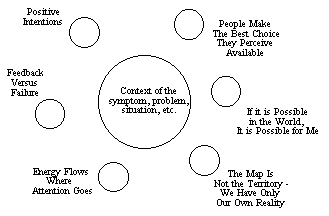Crediting a source is typically done by referring to the name(s) of the author(s) and the date of the work you are drawing from in the body of your publication, and then including a full reference to the work in a 'bibliography' or 'references' section of your manual, book or publication.
Consider the following example, from Tools for Dreamers (Dilts, Epstein & Dilts, 1993, pp. 23-24), referring to the T.O.T.E. model:
"A mental strategy is typically organized into a basic feedback loop called a T.O.T.E. (Miller, Gallanter & Pribram, 1960). The letters T.O.T.E. stand for Test-Operate-Test-Exit. The T.O.T.E. concept maintains that all mental and behavioral programs revolve around having a fixed goal and a variable means to achieve that goal. This model indicates that, as we think, we set goals in our mind (consciously or unconsciously) and develop a TEST for when that goal has been achieved. If that goal is not achieved we OPERATE to change something or do something to get closer to our goal. When our TEST criteria have been satisfied we then EXIT on to the next step."Since there is no direct quotation of Miller, Gallanter and Pribram's work, it has been cited parenthetically. In the back of the practitioner booklet is bibliography including a full reference their work in which they offer their own definition and description of the T.O.T.E. This typically includes: title of publication, author, publisher, city, state or country, and date of publication:
Plans and the Structure of Behavior, Miller, G., Galanter, E., and Pribram, K., Henry Holt & Co., Inc., 1960.
As an example, consider the following discussion of "congruence," taken from the 1998 NLPU 100A Practitioner manual (p.46):
According to Webster's Dictionary, "congruence" in a system is "marked by inner harmony, coherence, or agreement of its parts." In NLP, a state of congruence is a result of all of a person's internal beliefs, strategies and behaviors being in full agreement and oriented toward securing a desired outcome. For this reason, congruence is considered an essential resource state in NLP. The notion of congruence has been fundamental to NLP since its inception.Again, in the back of the practitioner booklet is bibliography including a full reference for The Structure of Magic: The Structure of Magic Vol. II, Grinder, J. and Bandler, R.; Science and Behavior Books, Palo Alto, California, 1976.In The Structure of Magic Volume II (1976), Grinder and Bandler defined congruence in the following way:
The term 'congruency' is used to describe a situation in which the person communicating has aligned all of his output channels so that each of them is representing, carrying or conveying the same or a compatible message. When all of a person's output channels (body posture and movements, voice tonality and tempo, words) are representing the same or compatible messages, the person is said to be congruent. Other people's experience of a congruent human being is usually described in terms of that persons's having personal presence, knowing what he is talking about, being charismatic, dynamic and a host of other superlatives. (p. 45)Congruence may be contrasted with "incongruence," which refers to a state of inner conflict resulting from inner struggle, typically at the level of beliefs or identity. These struggles are usually at a deeper level and are less conscious than typical cognitive activities. For this reason, the factors influencing states of congruence or incongruence are often outside of awareness. Thus, maintaining a state of congruency involves learning to pay attention to and interpret signals from one's unconscious mind.
The following is an example from the Pattern of the Month section of my web page on the Internet. My article on Operationalizing NLP Presuppositions includes the following description:
NLP Presuppositions Exercise
The following exercise, designed by Tim Hallbom and Suzi Smith, is another way to operationalize NLP presuppositions with respect to a specific symptom, situation or problem. It involves establishing reference experiences for each presupposition and then transferring them into a particular context in which you would like to experience them more strongly.First, lay out a space for the problem context or situation. Then arrange a series of locations, representing various NLP presuppositions, around the problem situation.
- Standing in the context space, access the symptom or problem state, and the context in which it occurs to create an anchor.
- Step into each presupposition space, accessing and anchoring the idea, then look at yourself in the problem context (disassociated), through the filters of the presupposition.
- Access the presupposition fully, then step into the context space, adding the presupposition.
- Continue around the circle until all spaces have been accessed and integrated.
(Copyright © 1995-1997 by Tim Hallbom and Suzi Smith. Reprinted with permission.)In this case, no specific reference has been made to another publication, because the exercise has not yet been published in book or other major publication. This reference would be added, and included in the bibliography of the manual, when such a source was published.
In general, if you are going to make a substantial quotation of content from somebody's work, it is good practice to get their approval ahead of time, such as a signed letter of release. When asking for permission to use copyrighted material, you should furnish the following information:
- The pages you want to use, titles, and/or page numbers in a specific publication.
- The group or publication that will be receiving the information.
- Where and when you will be using the materials.
- The number of copies you want to make.
The publisher or author may request a nominal fee for some reproduction, depending on how the material is to be used.
